Technologies
Apple’s Mixed Reality Headset: What to Expect From WWDC’s Big Reveal
Long-awaited and still mysterious, Apple’s VR headset could be the spark for a whole new wave of hardware and software.

Apple’s next big product looks like it’ll cost $3,000, rest on your face and need to be tethered to a battery pack. Whatever this expected VR headset ends up being, it isn’t immediately clear what it’ll do or who it’s for. The Reality Pro headset, as it’s expected to be called when it’s likely unveiled at Apple’s WWDC developer conference on June 5, is Apple’s biggest new product in nearly a decade. It’s also totally different than anything Apple has ever made before.
VR headsets have been a standard consumer tech thing for years, and your family, or families you know, may already have one lying in a corner. They’re used for games, fitness, creative collaboration, even theater. Still, VR and AR have been outlier technologies, not deeply connected enough to the phones, tablets and laptops most of us use every day.
Apple could change that. And of course, don’t expect the word «metaverse» to be uttered even once. The metaverse became Meta’s buzzword to envision its future of AR and VR. Apple will have its own parallel, possibly unique, pitch.
A connection to everything?
I pair my Quest 2, from Meta, to my phone, and it gets my texts and notifications. I connect it to my Mac to cast extra monitors around my desk using an app called Immersed. But VR and AR don’t often feel deeply intertwined with the devices I use. They aren’t seamless in the way my watch feels when used with an iPhone, or AirPods feel when used with an iPad or Mac.
Apple needs this headset to bridge all of its devices, or at least make a good starting effort. Reports say the headset will run iPad apps on its built-in 4K displays, suggesting a common app ecosystem. It’s also possible that the Apple Watch could be a key peripheral, tracking fitness and also acting as a vibrating motion-control accessory.
VR is a self-contained experience, but mixed reality – which Apple’s headset should lean on heavily – uses pass-through cameras to blend virtual things with video of the real world. In Apple’s case, its own devices could act as spatially linked accessories, using keyboards and touchscreens and ways to show virtual screens springing from real ones.
Apple’s expected headset is supposed to be self-contained, a standalone device like the Quest 2 and Quest Pro. But that interconnectivity, and its position in Apple’s continuity-handoff connected ecosystem, is a big opportunity and a big question mark.
However, Apple does have a big AR head start: Its iOS ecosystem has supported AR for years, and the iPhone and iPad Pro already have depth-sensing lidar scanners that can map out rooms in ways that Apple’s headset should replicate. Apple could emphasize making its existing AR tools on other devices more usable and visible through a new interface.
Apple’s head of AR, Mike Rockwell – the person expected to be leading this new headset’s development – told me in a conversation about AR in 2020 that «AR has enormous potential to be helpful to folks in their lives across devices that exist today, and devices that may exist tomorrow, but we’ve got to make sure that it is successful. For us, the best way to do that is to enable our device ecosystem, so that it is a healthy and profitable place for people to invest their time and effort.»
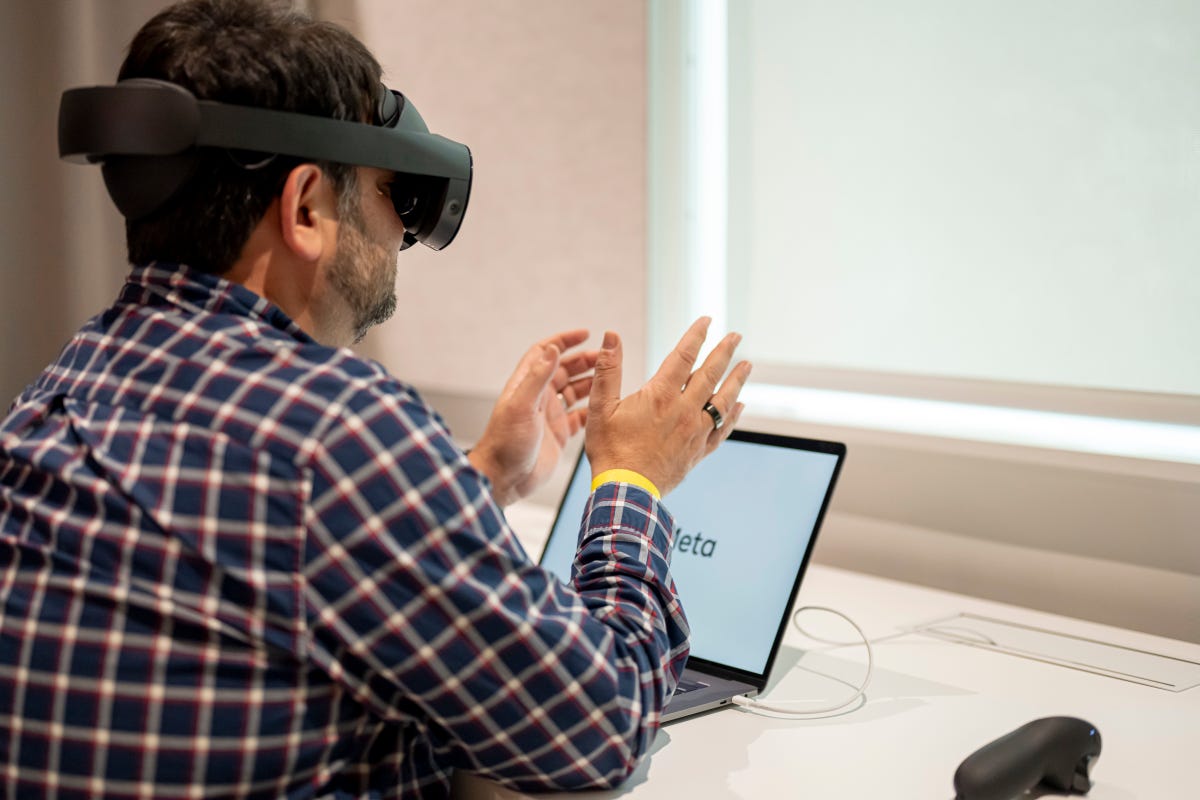
The Quest Pro and other headsets already support hand tracking. Will Apple refine the technology?
How do we control it?
I’m less curious about the Apple headset display – which sounds extremely promising with a possible 4K resolution per eye and a Micro OLED display – and more focused on how Apple solves what we do with our hands.
Interfaces in VR and AR are very much a work in progress. VR has tended to lean on split game controllers for most inputs, with optional (and steadily improving) hand tracking that still isn’t perfected.
Apple isn’t expected to have any controller at all with its Reality Pro headset. Instead, it’ll likely use both eye tracking and hand tracking to create a more accurate and possibly streamlined style of interface that could make targeting intended actions feel faster. Eye tracking already works this way, sometimes, in headsets that use it: The PlayStation VR 2 has some games that use eye tracking for controlling menus.
Accessibility is a big question here. Apple’s design choices are often very accessibility-conscious, and VR and AR headsets often rely on eye movement or physical hand movements that aren’t always easy for everyone. Voice control is a possible option here, or maybe some Apple Watch-connected functions that improve gesture accuracy and offer some touch controls could be in the cards, too. I don’t know. Apple already added some gesture controls for accessibility purposes on the Apple Watch, so the door’s open.
A lot of hand gestures in VR feel complicated to me, and involve lots of movement. Can Apple make a gesture language that feels as intuitive and as easy as multitouch on iPhones and iPads? It’s a big hurdle.
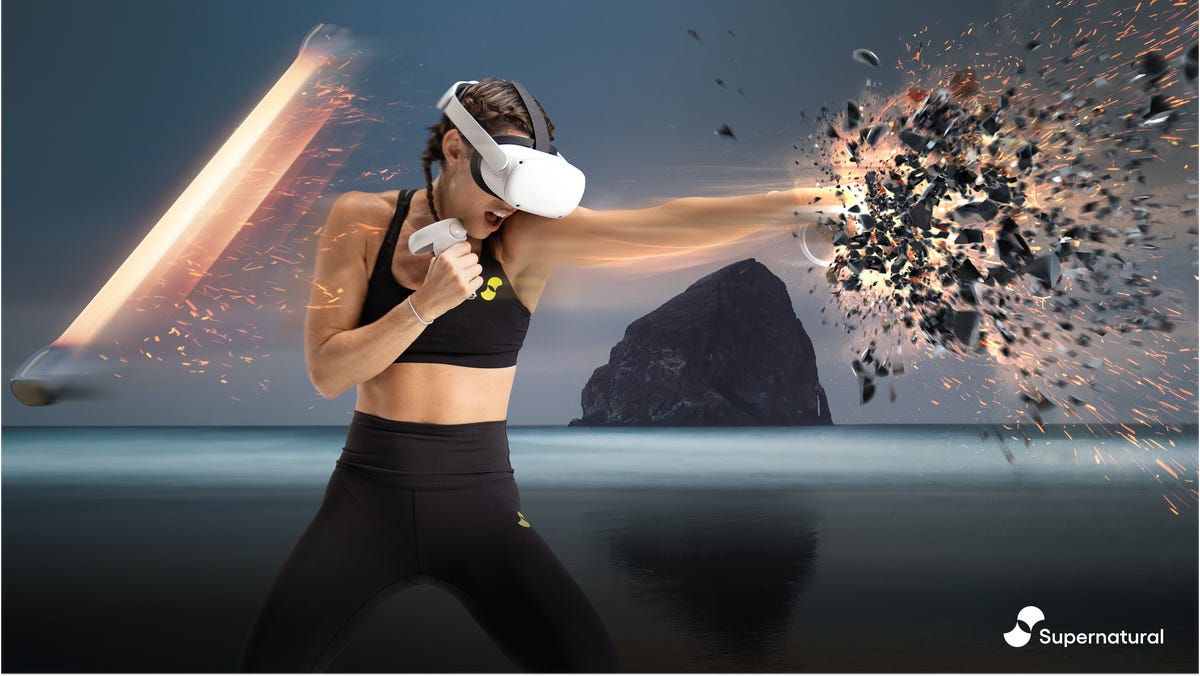
Supernatural has been a popular VR fitness app for the Meta Quest 2 for years.
Fitness focus
VR has already been a surprisingly effective fitness tool for years. Apple could address a whole bunch of opportunities that could open the landscape a lot further, though.
I’ve used Beat Saber and Supernatural on the Quest 2 for years as home exercise options, but the Quest 2 (and most VR headsets) aren’t designed with fitness in mind. Foam and silicone face pieces get sweaty, hardware can feel weirdly balanced, and no company has really spent targeted effort yet on making headgear that’s aimed at breathability and comfort like a piece of athletic equipment. There are plenty of third-party Quest accessories that help, but it still feels like an imperfect situation.
That’s Apple’s wheelhouse. After designing the Apple Watch, AirPods and, most recently, the Watch Ultra’s new straps, conceiving of materials and design that could feel better during workouts seems like an achievable goal. If the Reality Pro feels like a better piece of workout gear, it could inspire others to invest in better designs, too.
Apple should, and could, integrate the Apple Watch and fitness and health tracking into the headset’s functions. The Quest 2 can do this too to some degree, but most smartwatches and fitness trackers, like Fitbit, don’t have deep connections with VR headsets yet. They should, and again, introducing a clear wearable relationship between watch and headset feels like an overdue bridge.
Of all the things I’m trying to imagine Apple positioning an expensive headset to be in people’s lives, a fitness device keeps coming to mind as a much more likely proposition than a gaming gadget. Not that many people own gym equipment, or have space for it. Could headsets fill that role? I think they could. For me, they already do, sometimes.
Will Apple just focus on making it a great wearable display?
I’m starting to wonder if maybe Apple’s first goal with Reality Pro is just to nail a great audio/video experience. I’ve thought of VR/AR glasses as eventually needing to be «earbuds for your eyes,» as easy to use and as good as headphones are now. VR and AR headsets I’ve used all far short of being perfect displays, with the exception of the highly expensive Varjo XR-3. Could Apple achieve making the Reality Pro a headset that looks and sounds good enough to truly want to watch movies in?
Some reports that the Apple headset runs iPad apps, and that perhaps the iPad Pro with its lidar/camera array is in fact the «developer kit» for the headset, make me wonder if the headset will feel like a wearable extension of iOS rather than a whole new experience.
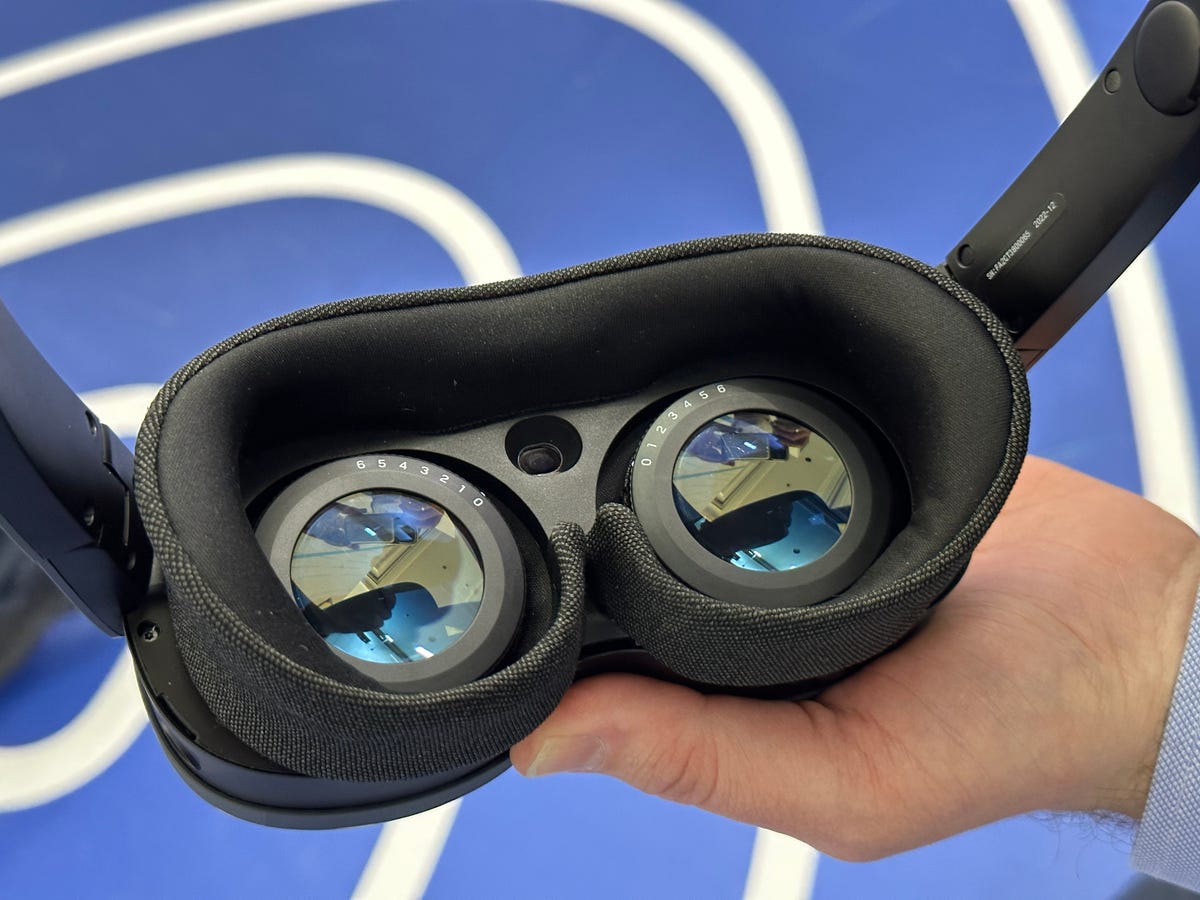
The inside of the Vive XR Elite: prescription adjustments allow a wide range of vision to fit… but not as wide as mine.
What about my glasses?
VR and AR headsets aren’t making it easy for me to live with my own eyewear. Some hardware fits right over my own chunky glasses, and some doesn’t. As headsets get smaller, a lot of them are trying to add vision-adjustment diopters right into the hardware – like the Vive XR Elite – or add optional prescription inserts.
Maybe someday we’ll have AR glasses that double as our own everyday glasses, and Apple can morph into a Warby Parker optical shop for its retail glasses fittings. In the meantime, these sometimes-on headsets also need to work without being annoying. Am I going to have to order prescription lenses? And how? And will they fit my needs? It’s a big responsibility for VR/AR manufacturers, and I’ve found that some of the insert options don’t meet my heavily near-sighted needs.
What are the killer apps?
Finally, of course, I’m curious about how this headset is defined. The Quest 2 is a game console with benefits. The Quest Pro was aimed at work. The PlayStation VR 2 is a PS5 extension.
The iPhone was a browser, an iPod, and an email device at first. The iPad wanted to be an easy way for users to read and look at the web. The Apple Watch was a fitness device, iPod, and wrist-communicator. What will Version One of the Apple Mixed Reality Headset be positioned as?
Apple did pepper a ton of extras into the Apple Watch at first, almost to test the waters with possibilities: a camera remote, a virtual way to send love taps and scribbles, voice memos. Reports of an avatar-based FaceTime, multiscreen immersive sports, and maybe 3D immersive versions of Apple’s already 3D-enabled Maps are clear starts. Apple’s collaborative Freeform app could be pitched as a mixed reality workplace, and movies could be watched in a virtual theater, in a way that VR headsets have enabled for years (but maybe here with an even better display and audio). AR-enabled iPhone and iPad home improvement apps, 3D scanning apps, and games could be ported over, leaning on similar lidar-scanning AR functions in-headset. Apple fitness workouts, clearly, could be big. Gaming? With Arcade, or some early partners, sure.
Will any of these be enough? Will Apple define a territory that right now has had a hard time defining itself beyond gaming? This first headset may not be the one most people buy, but it could be the one that tries to map out some clear directions for development beyond gaming. With Samsung and Google’s headset on the horizon, and possibly a lot more after that, these devices will start to reinvent themselves as they become more phone-connected and portable. Apple could have an early chance at shaping that narrative… or, if it doesn’t, others will get a chance after Apple. We’ll likely know more, or at least get an early glimpse, at WWDC.
Technologies
New Moto Things Include a Stylus for the Razr, Revamped Location Tracker
The Moto Pen Ultra will bring handwriting to the upcoming Razr Fold, while the Moto Tag 2 doubles the battery life of its predecessor to two years.
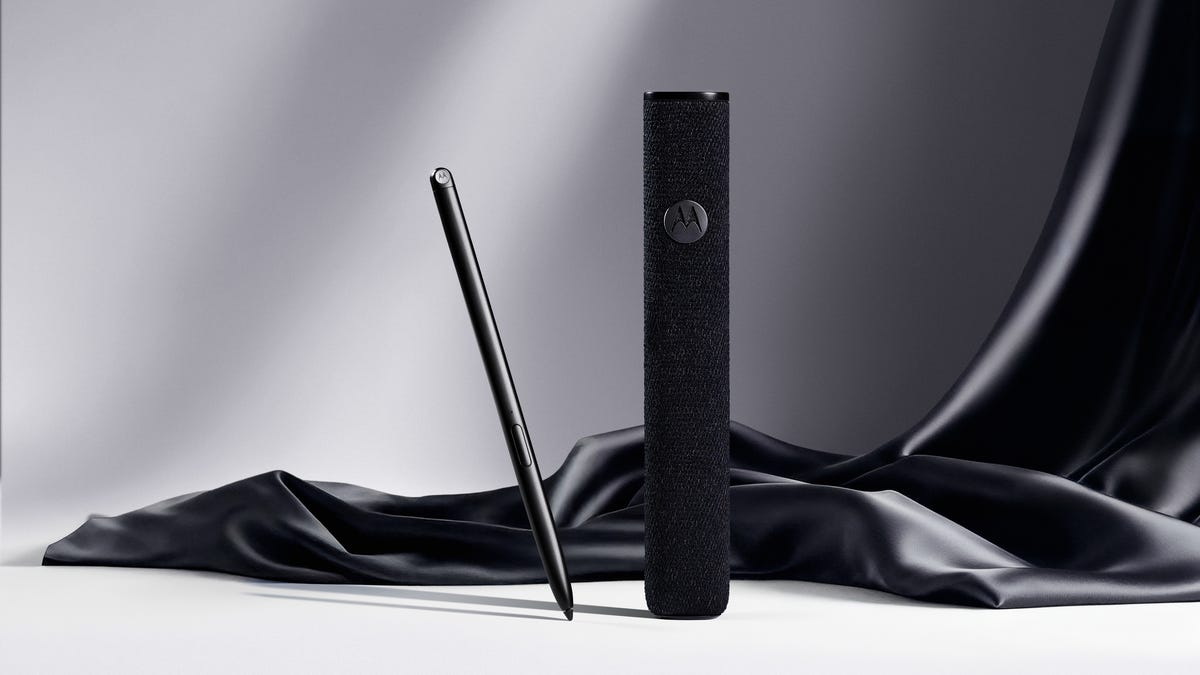
Motorola’s just-announced Razr Fold will be getting a premium stylus, which will arrive alongside a revamped location tracker.
The Moto Pen Ultra and Moto Tag 2 were announced Tuesday at CES 2026 during the Lenovo Tech World conference, debuting alongside the new Moto Watch as part of the Moto Things accessory line.
The Moto Pen Ultra comes with a magnetic case, which will then charge the stylus over USB-C. The pen features 4,096 levels of pressure sensitivity and a 6-axis motion sensor to assist with writing, drawing and sketching. When using the Pen Ultra with the Razr Fold, the stylus supports palm rejection and a range of tools from a quick access toolbar like Quick Clip for highlighting and sending content into a note for later.
While Motorola has made a series of stylus-equipped phones for its lower-cost Moto G line, the Pen Ultra appears to be specifically for the more flagship level devices Motorola makes like the Razr Fold.
The Pen Ultra is joined by the Moto Tag 2, which is an updated location tracker that supports Google’s Find Hub network. The Moto Tag 2 features double the battery life of the tracker it replaces, with Motorola stating it should last for two years. The Moto Tag 2 also supports ultra wideband to assist with precise location tracking.
Neither the Moto Pen Ultra nor the Moto Tag 2 had their pricing and release dates announced as part of the Tuesday event. The accessories join other announcements made by Motorola at Lenovo Tech World, which include the FIFA World Cup edition of the Motorola Razr and the Qira AI assistant.
Technologies
I Saw a Creaseless Foldable Screen at CES That Could End Up in the iPhone Fold
Samsung Display flexes its latest OLED concepts, and one in particular appeared to be the most promising.
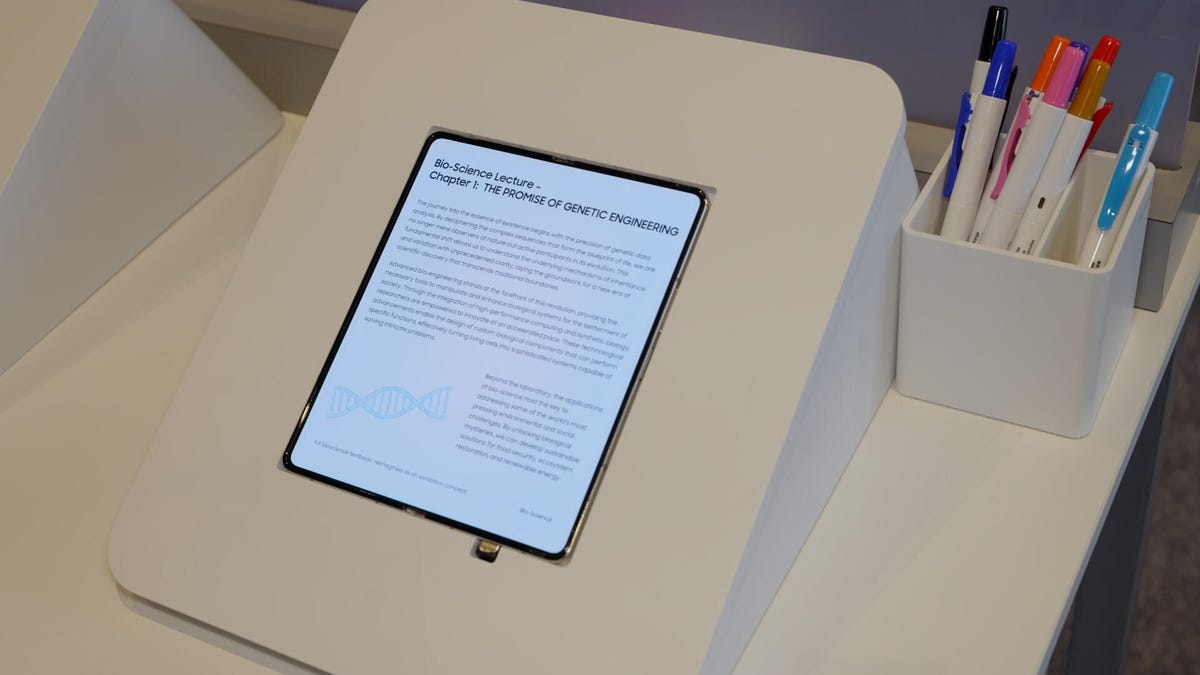
Foldable phones have become thinner, more powerful, and sturdier over the years, but one attribute has remained constant: the crease on the inside display. At CES 2026, I saw a concept that eliminates that center line for a more seamless look.
Samsung Display, which is known for showing off futuristic concepts that may or may not make it out into the real world, showed off a prototype of an OLED foldable display that paints a picture of what may be on the horizon.
Admittedly, all I could think about was whether I’d be seeing something like this in the rumored iPhone Fold, if and when it makes its long-awaited debut.
The company placed two phone models side by side: one that was simply dubbed a «current» device (Samsung Display wouldn’t confirm if it’s the Galaxy Z Fold 7), and another that’s a concept. Looking at the two phones, the difference was striking. When viewing the concept screen directly and at an angle, I couldn’t really see the line down the center that characterizes present-day foldables. The current phone instantly looked outdated.
This is particularly meaningful amid reports that Apple is working with Samsung Display to make a creaseless foldable iPhone. The foldable has been rumored for years, and it appears Apple is taking its time to nail the design, with an emphasis on nixing that pesky crease. Perhaps what I saw at Samsung Display’s booth is a concept that will morph into what Apple equips its iPhone Fold with. But we’ll have to wait until the end of this year at the earliest to find out.
Samsung Display’s creaseless screen is also designed to be more durable. To demonstrate this, the company had a robotic arm fling a basketball at a «backboard» made of several foldable concept phones, and none of them got cracked or dented. I still flinched every time.
The creaseless foldable screen was one of several concepts Samsung Display showed off at CES. The company also had a vehicle mock-up equipped with OLED displays, including a curved, 18.1-inch L-shaped center screen for controlling climate, navigation and more. A 13.8-inch passenger display can move into and out of the dashboard for storage, and there’s an option that prevents the driver from seeing what’s on the passenger’s screen to avoid being distracted.
Samsung Display also had robots that are designed to be teaching assistants. They can guide students to classrooms, share information about professors and display assignments on a circular screen that serves as the «face.» We didn’t really see it carry out commands at the demo, but I was nonetheless enamored by the cute little robotic arms.
Despite all the futuristic notions, the one that stuck with me most was the creaseless display because of its practicality. It’s not clear how many of Samsung Display’s concepts will ever leave the lab, but if any of them do, I hope it’s that one.
Technologies
Today’s NYT Connections Hints, Answers and Help for Jan. 7, #941
Here are some hints and the answers for the NYT Connections puzzle for Jan. 7, #941
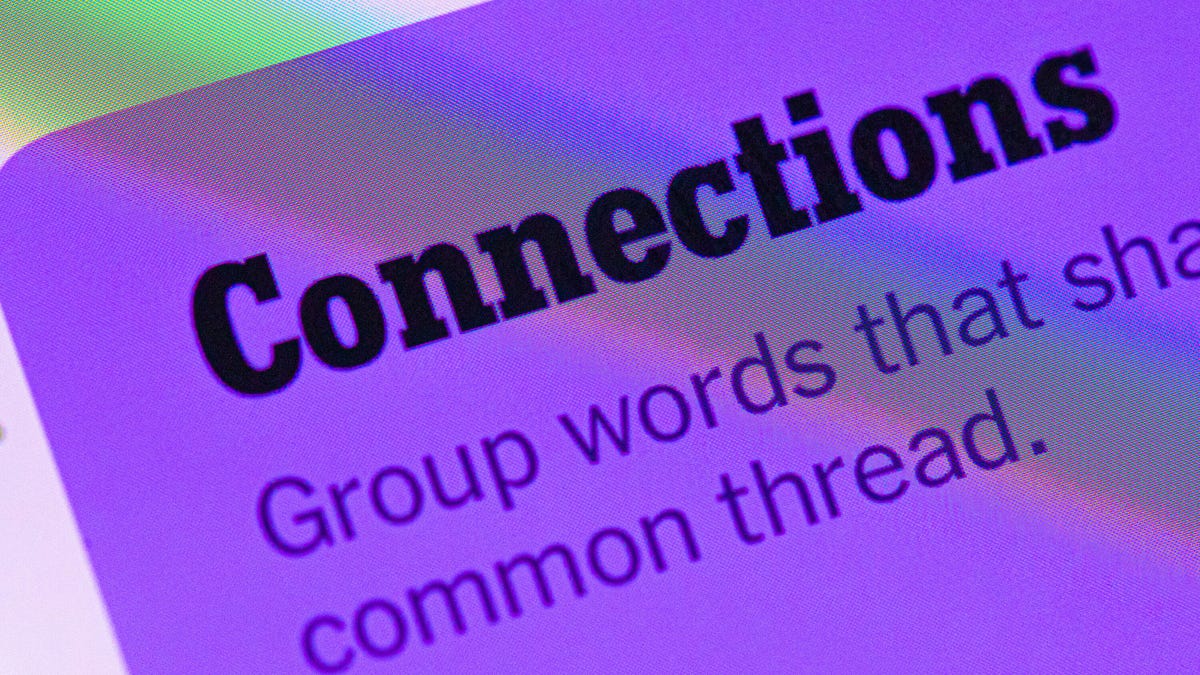
Looking for the most recent Connections answers? Click here for today’s Connections hints, as well as our daily answers and hints for The New York Times Mini Crossword, Wordle, Connections: Sports Edition and Strands puzzles.
Today’s NYT Connections puzzle is rather tricky. The purple category is especially mystifying. Read on for clues and today’s Connections answers.
The Times has a Connections Bot, like the one for Wordle. Go there after you play to receive a numeric score and to have the program analyze your answers. Players who are registered with the Times Games section can now nerd out by following their progress, including the number of puzzles completed, win rate, number of times they nabbed a perfect score and their win streak.
Read more: Hints, Tips and Strategies to Help You Win at NYT Connections Every Time
Hints for today’s Connections groups
Here are four hints for the groupings in today’s Connections puzzle, ranked from the easiest yellow group to the tough (and sometimes bizarre) purple group.
Yellow group hint: Lookalikes.
Green group hint: Part of something.
Blue group hint: National symbol.
Purple group hint: Squish down.
Answers for today’s Connections groups
Yellow group: Doppelgänger.
Green group: Portion.
Blue group: Common flag symbols.
Purple group: Pressed using a press.
Read more: Wordle Cheat Sheet: Here Are the Most Popular Letters Used in English Words
What are today’s Connections answers?
The yellow words in today’s Connections
The theme is doppelgänger. The four answers are clone, double, mirror and ringer.
The green words in today’s Connections
The theme is portion. The four answers are concern, interest, share and stake.
The blue words in today’s Connections
The theme is common flag symbols. The four answers are crescent, cross, star and stripe.
The purple words in today’s Connections
The theme is pressed using a press. The four answers are cider, garlic, trousers and wine.
Don’t miss any of our unbiased tech content and lab-based reviews. Add CNET as a preferred Google source.
-

 Technologies3 года ago
Technologies3 года agoTech Companies Need to Be Held Accountable for Security, Experts Say
-

 Technologies3 года ago
Technologies3 года agoBest Handheld Game Console in 2023
-

 Technologies3 года ago
Technologies3 года agoTighten Up Your VR Game With the Best Head Straps for Quest 2
-

 Technologies4 года ago
Technologies4 года agoBlack Friday 2021: The best deals on TVs, headphones, kitchenware, and more
-

 Technologies4 года ago
Technologies4 года agoVerum, Wickr and Threema: next generation secured messengers
-

 Technologies4 года ago
Technologies4 года agoGoogle to require vaccinations as Silicon Valley rethinks return-to-office policies
-

 Technologies4 года ago
Technologies4 года agoOlivia Harlan Dekker for Verum Messenger
-

 Technologies4 года ago
Technologies4 года agoiPhone 13 event: How to watch Apple’s big announcement tomorrow
